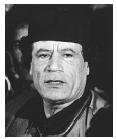LIBYA
Muammar al-Qadhafi
Head of State

(pronounced "moh-AH-mar al guh-DAH-fee")
"Now is the era of economy, consumption, markets, and investments. This is what unites people of irrespective of language, religion and nationalities."
Officially known as the Socialist People's Libyan Arab Jamahiriya, Libya is situated in the north of Africa. It is bordered by the Mediterranean Sea to the north, Egypt to the east, Sudan to the southeast, Chad and Niger to the south, and Algeria and Tunisia to the west. Much of Libya's land area is desert, part of the Sahara, with a few scattered oases throughout. Libya's capital is Tripoli, part of the northwestern region called Tripolitania. The other major city of the country is Benghazi, on the Cyrenaica peninsula in the northeast of the country and bordering the Mediterranean Sea, as is Tripoli. Libya's total surface area is 1,760,000 sq km (679,360 sq mi). The population has been estimated at 5,368,585, with an annual growth rate of 3%. The Libyan currency is the dinar . Per capita gross domestic product (GDP) was estimated at US $7,600 in 2001. That year, Libya had an estimated inflation rate of 13.6% and an unemployment rate of 30%. Arabic is the official language, and ethnically, Arabic-speaking Sunni Muslims of mixed Arab and Berber ancestry make up an estimated 97% of the indigenous population. The remaining groups are Greeks, Maltese, Italians, Egyptians, Pakistanis, Turks, Indians, and Tunisians. Libya's primary export is crude petroleum. Its major trading partners are Italy, Germany, Spain, France, the United Kingdom, and Greece.
ADDRESS
Office of the Secretary of Information & Culture
Tripoli, Libya
Comment about this article, ask questions, or add new information about this topic: